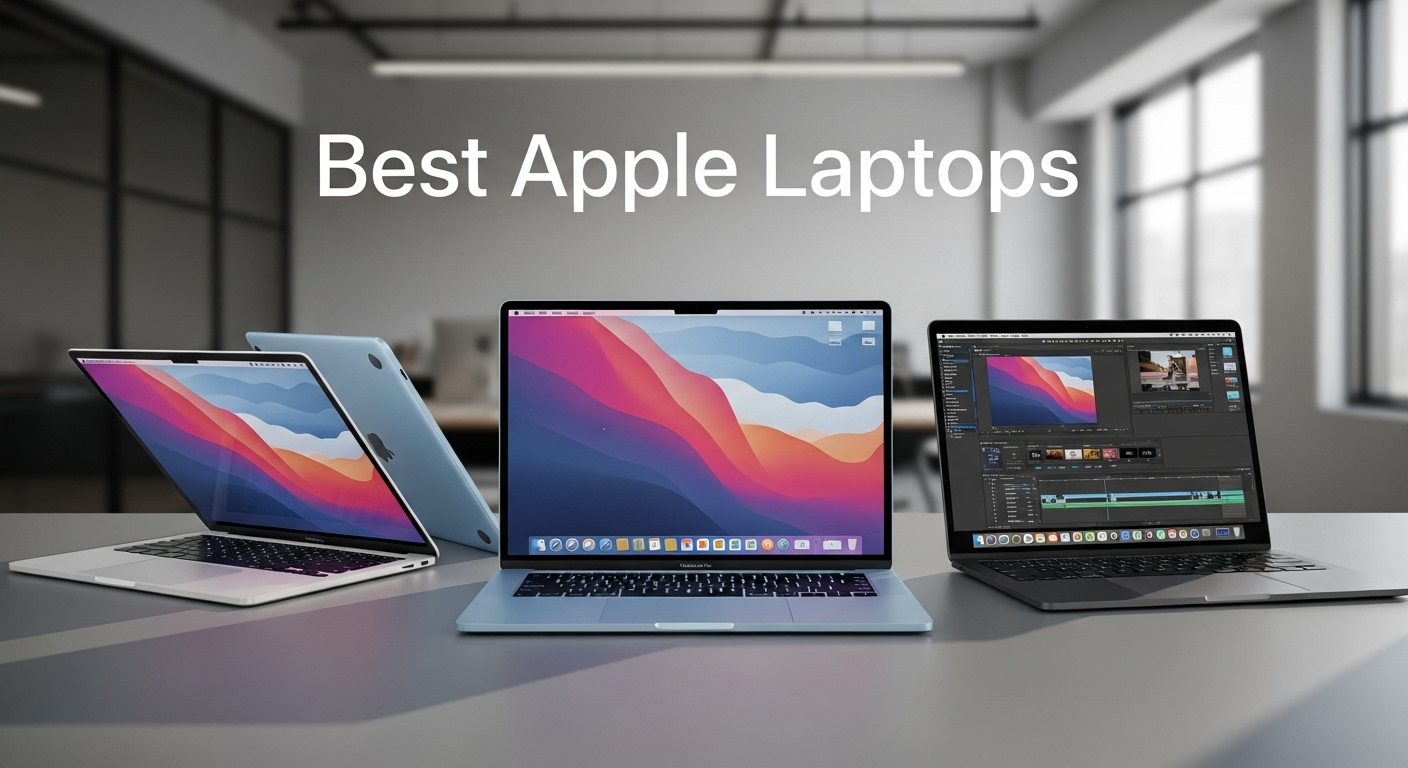
15 Best Laptops for Engineering Students in July 2025
- Laptop & PCs

Choosing the right Apple laptop in 2025 has never been more exciting or more complex. With Apple’s M4 chip now powering the latest MacBooks and a range spanning from budget-friendly renewed models to powerhouse Pro machines, there’s an Apple laptop for every creative professional, student, and everyday user.
We’ve tested and analysed 7 of the best Apple laptops currently available in July 2025, from the ultra-portable MacBook Air to the professional-grade MacBook Pro. Whether you’re editing 4K video, coding the next breakthrough app, or simply need a reliable machine for daily tasks, our comprehensive guide will help you find the perfect MacBook that balances performance, portability, and price.
| MacBook Model | Key Spec | Price | Best For | Check Price |
|---|---|---|---|---|
| MacBook Air 13″ (M4, 2025) | M4 Chip, 16GB RAM | $1,359 | Latest Performance | Amazon |
| MacBook Air 15″ (M4, 2025) | 15.3″ Display, 24GB RAM | $1,759 | Large Screen Productivity | Amazon |
| MacBook Pro 16″ (M4 Pro, 2024) | 20-Core GPU, 24GB RAM | $3,000+ | Professional Video/3D | Amazon |
| MacBook Pro 14″ (M3 Pro, 2023) | M3 Pro, 18GB RAM | $1,363 | Creative Professionals | Amazon |
| MacBook Air 13″ (M3, 2024) | M3 Chip, 16GB RAM | $988 | Balanced Performance | Amazon |
| MacBook Air 13″ (M2, 2022) | M2 Chip, 16GB RAM | $1,200+ | Solid Mid-Range | Amazon |
| MacBook Air 13″ (M1, 2020) | M1 Chip, 16GB RAM | $510 | Budget Option | Amazon |
Apple’s laptop lineup in 2025 centers around three key decisions: chip performance, screen size, and budget. The latest M4 chip delivers unprecedented performance-per-watt, making even the base MacBook Air capable of handling demanding creative tasks that previously required a MacBook Pro.
Chip Performance Hierarchy: The M4 represents Apple’s latest silicon, offering roughly 15-20% better performance than M3, which itself was a significant leap over M2. For most users, even the base M3 Air provides more than enough power for daily tasks, web browsing, and light creative work. The M4 Pro and Max chips in the professional lineup add specialized media engines and additional GPU cores for 4K video editing, 3D rendering, and complex software development.
Screen Size Considerations: The 13-inch models prioritize portability, weighing around 2.7-3.5 pounds and fitting easily in most bags. The 15-inch MacBook Air bridges the gap between portability and productivity, while the 14-inch and 16-inch Pro models offer professional-grade displays with mini-LED technology and higher brightness for color-critical work.
Memory and Storage: Apple’s unified memory architecture means RAM is shared between CPU and GPU, making 16GB the new sweet spot for most users. Creative professionals should consider 24GB or more, especially for video editing or running multiple virtual machines.
Don’t buy based solely on processor generation the M1 chip from 2020 still outperforms many Intel laptops released in 2024. Instead, focus on your actual workflow needs. Many users overspend on Pro models when a MacBook Air would serve them perfectly.
Avoid the base storage configurations if you plan to keep your MacBook for several years. Apple’s SSD upgrades are expensive, but external storage isn’t always convenient for a laptop. Consider the total cost of ownership, including potential dongles for port expansion, especially with the Air models’ limited connectivity.
Don’t ignore refurbished and previous-generation models. Apple’s build quality means a well-maintained M2 MacBook Air often provides better value than the latest M4 model, particularly if your workload doesn’t demand cutting-edge performance.
The M4 chip brings noticeable improvements in both single-core and multi-core performance compared to the M3, particularly benefiting tasks like photo editing in Lightroom, software compilation, and video conferencing with multiple participants. The 16GB of unified memory ensures smooth operation even with dozens of browser tabs, multiple creative applications, and background processes running simultaneously.
What sets this model apart is Apple’s refined manufacturing process, resulting in better thermal efficiency and longer sustained performance during intensive tasks. The 1TB storage configuration eliminates the constant storage management that plagues smaller capacity models, making this an excellent choice for photographers, content creators, and professionals who work with large files.
The brilliant Liquid Retina display supports the full sRGB color gamut and reaches 500 nits of brightness, making it suitable for photo editing and color-sensitive work, though it lacks the mini-LED technology found in Pro models.
The Apple 2025 MacBook Air 13-inch with M4 chip offers top performance, portability, and battery life, but has limited upgrade options and a higher price.
The larger display transforms the MacBook Air experience, providing comfortable side-by-side app usage, more detailed photo editing workspace, and better visibility for presentations. The 24GB of unified memory is particularly valuable for developers running multiple environments, designers working with large Photoshop files, or anyone who keeps extensive browser tabs open.
Despite the larger screen, Apple has maintained the Air’s signature thin profile and excellent battery life. The M4 chip’s efficiency means you still get close to all-day battery life, even with the larger display drawing more power. The improved speakers, made possible by the larger chassis, deliver surprisingly good audio quality for video calls and media consumption.
This model excels for consultants who need screen space for spreadsheets and presentations, content creators who want to see more timeline or canvas area, and students who benefit from having reference materials alongside their work. The only compromise compared to Pro models is the lack of additional ports you still get just two Thunderbolt/USB 4 ports and a headphone jack.
The M4 Pro chip delivers remarkable performance for video editing, 3D rendering, and software development. Final Cut Pro timelines with multiple 4K streams play back smoothly, while Blender renders that would take hours on older machines complete in minutes. The 20-core GPU provides enough power for light gaming and GPU-accelerated tasks like machine learning model training.
The Liquid Retina XDR display is the standout feature, offering 1,600 nits peak brightness, full P3 color gamut coverage, and precise color accuracy that rivals dedicated reference monitors. The mini-LED backlighting provides true blacks and exceptional contrast, making it ideal for HDR video editing and color grading work.
Professional connectivity sets this apart from Air models: three Thunderbolt 4 ports, HDMI 2.1 for 8K external displays, and an SD card slot that’s invaluable for photographers and videographers. The improved keyboard and larger trackpad enhance productivity during long work sessions.
Battery life remains impressive despite the powerful internals, easily lasting through a full workday of intensive tasks. The only considerations are the higher price point and increased weight, though at 4.7 pounds, it’s still reasonable for the performance delivered.
The M3 Pro delivers substantial performance improvements over the standard M3, particularly in multi-threaded tasks and GPU-intensive applications. Video editors will appreciate the additional media engines that accelerate H.264 and H.265 encoding, while photographers benefit from faster RAW processing in Lightroom and Capture One.
The 14.2-inch Liquid Retina XDR display provides the same mini-LED technology as the larger Pro model, with exceptional brightness and color accuracy in a more portable package. The smaller size actually increases pixel density slightly, resulting in incredibly sharp text and images that reduce eye strain during extended work sessions.
This configuration with 18GB of unified memory handles complex Logic Pro projects, multiple virtual machines, and large Photoshop files without performance degradation. The 512GB storage, while adequate for many users, may require external storage for video professionals working with large project files.
Professional connectivity includes three Thunderbolt 4 ports, HDMI, and SD card slot, matching the larger Pro model’s versatility. The excellent keyboard and Force Touch trackpad make this a pleasure to use for coding, writing, and detailed design work.
The M3 chip provides a significant performance boost over the M2, particularly in GPU-intensive tasks. Photo editing in apps like Affinity Photo and Pixelmator Pro feels snappy, while the additional GPU cores handle light video editing and casual gaming with ease. The 16GB of unified memory ensures smooth multitasking between productivity apps, web browsers, and creative software.
This model excels as a daily driver for college students, business professionals, and content creators who primarily work with photos and 1080p video. The 512GB storage provides adequate space for applications, documents, and a reasonable photo library without constant storage management.
The fanless design maintains complete silence during normal use, making it ideal for libraries, coffee shops, and quiet office environments. Battery life consistently reaches 15-18 hours of real-world use, easily lasting through full days of classes or work sessions.
The Liquid Retina display, while lacking the mini-LED technology of Pro models, still delivers accurate colors and sufficient brightness for most tasks. The P3 color gamut support makes it suitable for photo editing, though video colorists may prefer the Pro models’ enhanced displays.
The M2 chip remains highly capable for most users, handling everything from office productivity to photo editing and light video work. The performance difference between M2 and M3 is noticeable in benchmarks but less apparent in real-world usage for typical tasks like web browsing, document editing, and media consumption.
This model introduced the larger 13.6-inch display with thinner bezels, providing more workspace while maintaining the compact footprint. The Midnight color option has become popular for its sophisticated appearance, though it does show fingerprints more readily than lighter colors.
The 16GB/512GB configuration eliminates the main pain points of base models: insufficient RAM for modern multitasking and limited storage for applications and files. This setup provides comfortable headroom for students running multiple applications, professionals working with moderate-sized files, and casual creative users.
Battery life remains excellent, typically achieving 12-15 hours of mixed use. The MagSafe charging port, reintroduced with this generation, provides convenient charging while preserving Thunderbolt ports for peripherals.
Performance and Specifications:
The M1 chip marked Apple’s transition from Intel processors and still delivers impressive performance for everyday tasks. Web browsing feels snappy, office applications run smoothly, and photo editing in apps like Photos and Lightroom remains responsive. While it lacks the raw power of newer chips, the M1 provides more than adequate performance for students, casual users, and professionals with moderate computing needs.
The fanless design ensures completely silent operation, making this ideal for quiet environments like libraries or bedrooms. Battery life, while not quite matching newer models, still easily achieves 10-12 hours of typical use, making it suitable for full-day mobile computing.
The main limitation is the 256GB storage, which fills up quickly with applications, photos, and documents. External storage or cloud services become necessary for users with large file collections. However, the 16GB of unified memory prevents the performance degradation that plagues 8GB configurations when multitasking.
As a renewed product, this MacBook has been inspected and tested to work and look like new, backed by Amazon’s return policy. For students entering college, professionals needing a reliable secondary machine, or anyone wanting to experience Apple’s ecosystem without a significant investment, this represents exceptional value.
Best Under $600: Apple MacBook Air 2020 (M1, Renewed) – $510 The renewed M1 Air delivers incredible value for basic computing needs. While storage is limited, the performance and build quality rival much more expensive Windows laptops.
Best $900-$1,400: Apple MacBook Air 13″ (M3, 2024) – $988 The M3 Air with 16GB RAM provides modern performance and adequate storage for most users. It’s the sweet spot between capability and cost.
Best $1,400-$1,800: Apple MacBook Air 15″ (M4, 2025) – $1,759 For users who need more screen space, the 15-inch M4 Air offers excellent productivity features without pro-level pricing.
Best Premium Option: Apple MacBook Pro 16″ (M4 Pro, 2024) – $3,000+ When budget isn’t the primary concern, this machine handles any professional workflow with room to grow.
| Model | Chip | RAM | Storage | Display | Price |
|---|---|---|---|---|---|
| MacBook Air 13″ (M4, 2025) | M4 | 16GB | 1TB | 13.6″ Liquid Retina | $1,359 |
| MacBook Air 15″ (M4, 2025) | M4 | 24GB | 1TB | 15.3″ Liquid Retina | $1,759 |
| MacBook Pro 16″ (M4 Pro, 2024) | M4 Pro | 24GB | 1TB | 16.2″ XDR | $3,000+ |
| MacBook Pro 14″ (M3 Pro, 2023) | M3 Pro | 18GB | 512GB | 14.2″ XDR | $1,363 |
| MacBook Air 13″ (M3, 2024) | M3 | 16GB | 512GB | 13.6″ Liquid Retina | $988 |
| MacBook Air 13″ (M2, 2022) | M2 | 16GB | 512GB | 13.6″ Retina | $1,200+ |
| MacBook Air 13″ (M1, 2020) | M1 | 16GB | 256GB | 13.3″ Retina | $510 |
What’s the difference between MacBook Air and MacBook Pro in 2025?
MacBook Air models prioritize portability and battery life with fanless designs, while MacBook Pro models offer more processing power, better displays with mini-LED technology, and additional ports. Pro models also include active cooling for sustained performance during intensive tasks.
Is 16GB of RAM enough for a MacBook in 2025?
Yes, 16GB is the new sweet spot for most users. Apple’s unified memory architecture shares RAM between CPU and GPU efficiently. However, professionals working with 4K video, large datasets, or multiple virtual machines should consider 24GB or more.
Should I buy an M3 or wait for M4 MacBooks?
If you need a laptop now, the M3 MacBooks offer excellent performance and value. The M4 provides roughly 15-20% better performance, which is meaningful for intensive tasks but less noticeable for everyday use. Consider your budget and immediate needs.
Can MacBooks handle gaming in 2025?
Apple Silicon Macs can handle many games, especially those optimized for Metal. Popular titles like Baldur’s Gate 3, Resident Evil Village, and indie games run well. However, the gaming library is still limited compared to Windows, and dedicated gaming laptops offer better performance per dollar for gaming.
What’s the best MacBook for college students?
The M3 MacBook Air 13″ with 16GB RAM and 512GB storage offers the best balance of performance, portability, and value for students. It handles coursework, light creative projects, and entertainment while lasting all day on battery.
Are renewed/refurbished MacBooks worth buying?
Yes, especially from reputable sellers like Amazon Renewed. Apple’s build quality means older MacBooks remain functional for years. The M1 MacBook Air at $510 renewed offers exceptional value, though check return policies and warranty coverage.
How long do MacBooks typically last?
Apple Silicon MacBooks should remain viable for 6-8 years with regular software updates. The M1 chip from 2020 still outperforms many current Windows laptops, suggesting excellent longevity for newer M3 and M4 models.
Should I get the 14-inch or 16-inch MacBook Pro?
Choose based on portability needs and budget. The 14-inch Pro offers nearly identical performance in a more portable package, while the 16-inch provides more screen real estate and slightly better sustained performance due to improved cooling.
What storage capacity should I choose?
512GB is adequate for most users who primarily work with documents, photos, and streaming media. Content creators, developers, and power users should consider 1TB or more. Apple’s SSD upgrades are expensive, so buy more storage upfront if uncertain.
Can I upgrade RAM or storage after purchase?
No, Apple Silicon MacBooks have memory and storage soldered to the logic board. Choose your configuration carefully, as upgrades aren’t possible after purchase. External storage can supplement internal storage but won’t match the speed of internal SSDs.
Which MacBook is best for video editing?
For professional video editing, choose a MacBook Pro with M3 Pro or M4 Pro chips. The additional GPU cores and media engines significantly accelerate video encoding and playback. For casual editing, the M3 or M4 MacBook Air handles 1080p and light 4K work admirably.
Do I need a MacBook Pro for programming?
Most programming tasks run excellently on MacBook Air models. The main advantages of Pro models for developers are additional ports for multiple monitors, more RAM for large codebases or containers, and sustained performance for long compilation jobs.
After analyzing these 7 Apple laptops in July 2025, here are our top picks for different users:
🏆 Best Overall Apple Laptop: Apple MacBook Air 13″ (M4, 2025) The latest M4 Air delivers cutting-edge performance, all-day battery life, and premium build quality at $1,359. It’s the laptop most people should buy, offering future-proof performance in Apple’s most refined design.
💰 Best Value: Apple MacBook Air 13″ (M3, 2024) At $988 with 16GB RAM and 512GB storage, this hits the perfect balance of modern performance and accessibility. The M3 chip handles virtually any task while maintaining excellent battery life and portability.
🎯 Best for Professionals: Apple MacBook Pro 14″ (M3 Pro, 2023) Creative professionals get Pro-level performance, an exceptional XDR display, and professional connectivity at $1,363. It’s significantly more capable than Air models without the bulk of the 16-inch model.
📱 Best Budget Choice: Apple MacBook Air (M1, 2020, Renewed) At just $510, the renewed M1 Air provides remarkable performance and build quality. Despite being four generations old, it still outperforms most Windows laptops and offers an affordable entry into the Apple ecosystem.
The Apple laptop landscape in 2025 offers something for everyone, from students stretching budgets to professionals demanding uncompromising performance. Whether you choose the latest M4 technology or find value in a previous generation, you’re getting access to Apple’s industry-leading design, exceptional battery life, and seamless integration with the broader Apple ecosystem.
Last updated: July 2025. Prices and availability subject to change.
